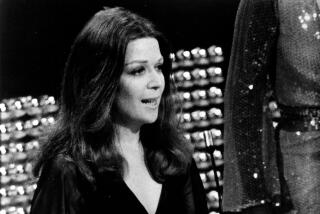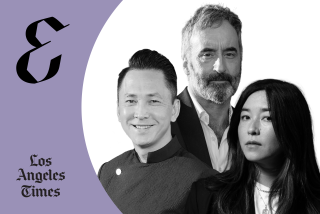Eisner Leaves the Venom out of His Book but Leaves in a Few Good Bites
- Share via
Michael Eisner will eat lunch in this town again.
In fact, Hollywood muckrakers and gossip mongers would do better dusting off their copies of Julia Phillips’ 1991 mean kiss-and-tell than picking up a copy of Eisner’s new autobiographical business book, “Work in Progress,” which they’d undoubtedly find a yawn.
But if, by Hollywood standards, there’s little deliciously venomous dish, there are some interesting takes on various Hollywood notables and a smattering of backhanded compliments that could cause some stir.
The Walt Disney Co. chief intentionally decided to play it safe when it came to recounting his life and times in Hollywood over the last three decades. In particular, he was excruciatingly tame and careful when writing about his fractured relationships with longtime friend Michael Ovitz and longtime charge Jeffrey Katzenberg.
Eisner well knows that some people in Hollywood will go directly to the book’s index to find such high-profile names as Ovitz and Katzenberg, bothering to read little else of the 434 pages on his upbringing and career at ABC, Paramount Pictures and Disney. Eisner even kidded to his collaborator, Tony Schwartz, that they should leave out an index altogether. Eisner believes some might actually applaud him for taking the high road. Certainly, his wife, Jane--who objected to his writing the book--is relieved.
“I decided to be a gentleman and not get venomous or angry,” says Eisner. “Everybody has their dark and light sides; I decided to focus on the light. . . . At Disney, I learned that it’s the safest road.”
He says that although he knew he had to write about Katzenberg and Ovitz--it would have been too conspicuous not to--”I did as little as I could to tell the story and not to exacerbate the problem.”
Because of a confidentiality agreement, Eisner avoided any mention in the book of the now-settled lawsuit in which Katzenberg sought as much as $250 million in pay he claimed Disney owed him.
However, in an early draft of the book, excerpts of which Katzenberg had access to as part of the lawsuit discovery process, Eisner apparently did take some nasty shots at his former studio chief, but all of those pages ended up on the cutting room floor.
“It had nothing to do with the Katzenberg suit being settled,” Eisner says. “The book was about 800 pages long, and in cutting it back to a readable version, every chapter got reduced.”
Eisner says he chose to take the high road when it came to detailing his long-term relationship with Katzenberg, which spanned some 18 years from their days at Paramount to Disney, and tried to present a “balanced picture” of their years together.
*
As much as Eisner goes to pains to credit Katzenberg for his contributions at Paramount and Disney, he also doesn’t miss the opportunity for a backhanded compliment or two.
“Occasionally, people succeed because they are brilliant and visionary; mostly, it’s because they work harder than everyone else. Jeffrey was certainly smart and he grew creatively. But, above all he was focused, driven and relentless.”
Katzenberg may not appreciate Eisner’s almost poetic description of him: “Even physically, he was efficient. His diminutive frame and lean, long face made him look as if all excess had been burned away, leaving only glasses and teeth.”
And at several junctures in the book, Eisner makes it clear how put off he was at Katzenberg’s bald aggressiveness in lobbying for the Disney presidency that began shortly after Frank Wells was killed in a helicopter crash in 1994.
“Less than 36 hours after Frank’s death, Jeffrey stunned me with an ultimatum over lunch. ‘Either I get Frank’s job as president,’ he said, ‘or I’m going to leave the company.’ ”
What does Katzenberg think of Eisner’s book and his version of the way things happened?
Through a representative, he said he wishes Eisner well and hopes the book is a success but hasn’t read it.
(And, if you believe that . . . )
“I’m sure he’ll just go to the index and read the parts about him,” Eisner says.
*
Sources said Ovitz--who declined to comment--also has not read the book and probably won’t since he is still smarting from a broken 25-year relationship with Eisner.
In an interview with The Times this week, Eisner was conciliatory toward his former ally, suggesting that they each had mishandled Ovitz’s short-lived tenure as Disney’s president and that he hopes one day they will again be friends.
Eisner’s book offers no real insights on Ovitz other than to confirm what had long been suspected (though denied until the bitter end): that the business relationship had become untenable some 16 months after its celebrated beginning.
In their final meeting the evening of Dec. 12, 1996, Eisner said it was painfully clear that “one of the casualties of our professional split was going to be our friendship.”
As Eisner said in an interview, relationships tend to become “Shakespearean” in Hollywood’s highly charged milieu because so much is at stake.
He also talks in the book about the fractured relationship he had with producer Larry Gordon, whom he describes as “a quintessential Hollywood character--brash, blunt, fast-talking, street-smart.”
Gordon, who had an overall producer’s deal at Paramount during Eisner’s tenure, was also one of Eisner’s few close friends in the business. As Eisner acknowledges in his book, he discovered that “doing business with your friends is always tricky.”
After producing and delivering for Paramount a huge hit in “48 Hours,” starring Nick Nolte and Eddie Murphy, Gordon wanted to make his directing debut on a script called “Brewster’s Millions.”
Universal Pictures wanted to make the movie, but not with a first-time director. Paramount agreed to let Gordon direct but insisted on paying him scale and retaining the right to replace him if the budget went over a certain figure. According to Eisner’s account, Gordon then went back to Universal, which not only agreed to let him direct but offered him a much more lucrative deal. Eisner’s book says that despite Gordon’s insistence that he got permission from Katzenberg to take the project to Universal, Eisner was “enraged” and felt betrayed that Gordon had “taken advantage of our offer” to get himself a better deal across town.
The next morning, Eisner severed Paramount’s ties with Gordon, ordering his furniture removed from the lot. Gordon won a temporary restraining order against the move and ultimately decided not to direct the movie, which turned out to be a box-office flop. The rift, which took a long time to heal, inspired Eisner to commission a script called “Worst of Friends,” which was never made but which he still thinks would make a great black comedy.
“If Michael was going to cast the movie, I’m sure Tom Cruise would play him and Charles Manson would play me,” joked Gordon, who’s once again friendly with Eisner.
Now that would be dishy.
More to Read
Sign up for our Book Club newsletter
Get the latest news, events and more from the Los Angeles Times Book Club, and help us get L.A. reading and talking.
You may occasionally receive promotional content from the Los Angeles Times.










